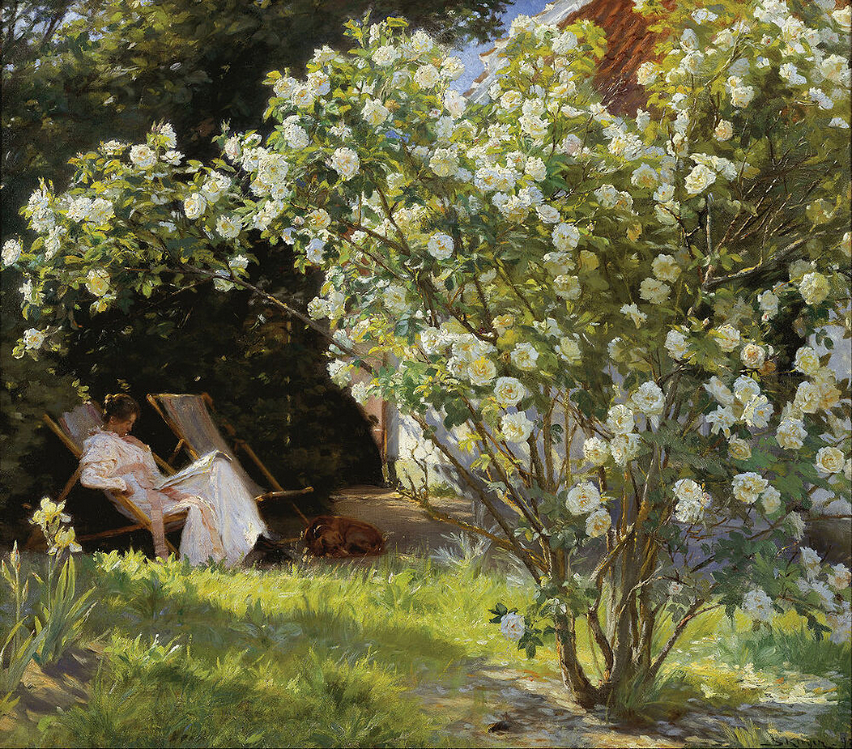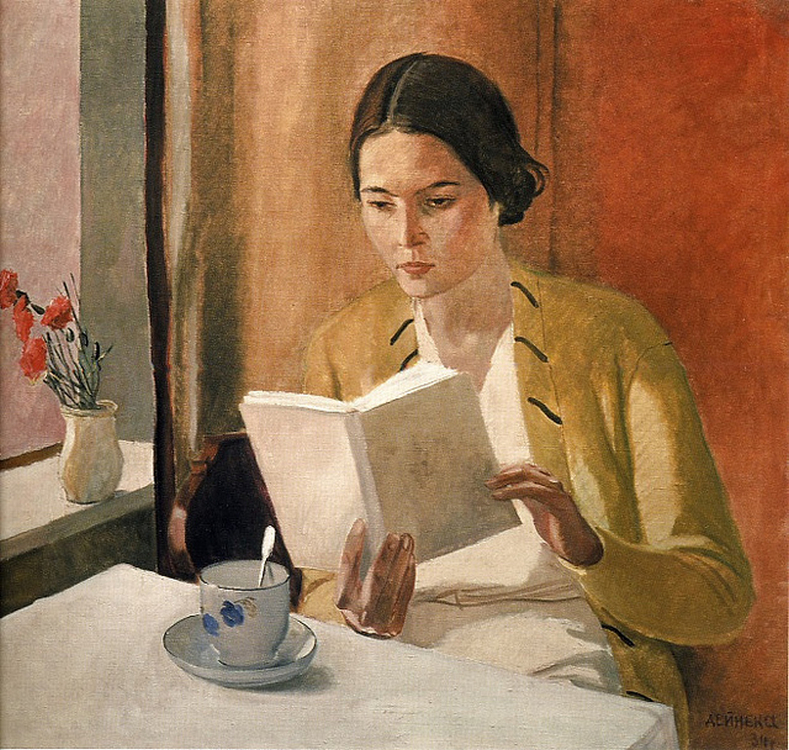 From the desk of Tracy Hickman:
From the desk of Tracy Hickman:
If you page through Women Who Read Are Dangerous looking for visual representations that most people associate with danger, you might be confused initially. None of the women are brandishing weapons or committing violent acts. Instead, they sit quietly perusing books, pamphlets, magazines, hymnals, and letters. Some subjects have been caught during a momentary pause in their reading, gazing back at the viewer or looking off to some far horizon of their imagination. Whatever their attitude, these women are self-contained, and their thoughts remain private. Could this be the danger referenced in the title? As a woman who reads, I was curious to find out.
The forward written by Karen Joy Fowler, author of the bestselling novel The Jane Austen Book Club, begins this exploration by considering the popularity of the subject of reading women for visual artists:
“Given the limited access to literacy women have historically had, women readers would seem to be overrepresented in the visual arts. But the image is an interestingly complicated one. We, the viewers, are invited to enter visually, mentally, a place we do not occupy—a garden, perhaps, or a sunlit room—in order to watch a woman who is visually, mentally, in another place. She might be time travelling—back to ancient Rome, forward to colonized Mars…
She might be having trouble concentrating, or she might be spellbound. She might be escaping from boredom into a frothy romantic comedy. She might be reading a Russian novel, a Japanese, assuring herself that others have also had their troubles. She might be pitting her wits against a world-famous detective. She might just need a good cry. Or she might be experiencing some transformation so profound that she will never be quite the same again. At the very moment we see her, the scales might be falling from her eyes…
The woman reader is perfectly still, pinned into place and completely unaware of us watching her. Simultaneously, she has escaped us entirely. Probably it’s the voyeurism that interests some artists. For others, let’s hope it’s the escape.” (14)

Woman Reading, by Pieter Janssens Elinga (56)
Author Stefan Bollmann’s introduction next examines historical trends in reading, starting with the development of the idea that “reading should give us pleasure” which he points out as being a relatively new idea that became mainstream in the eighteenth century.
“When the rage for reading began to take hold in the days of Chardin and Baudouin, first in Paris, then in other parts of the world, everyone, particularly women, carried a book in his or her pocket. This phenomenon, so disturbing to some contemporaries, rapidly gained supporters as well as critics. The former encouraged “useful” reading, which would channel “reading mania,” as it was known, toward virtuous and educational materials. Their conservative opponents saw in unrestrained reading further evidence of the inexorable decline in manners and social order.” (23)

Girl Reading, by Lovis Corinth (95)
In a section on “Silent Reading” Bollmann focuses on the opportunities for greater freedom that women gained through reading:
“With the ability to read, however, there developed new patterns of private behavior that were to threaten the legitimacy of both the Church and secular authorities on a permanent basis. Women who learned to read at that time were considered dangerous. For the woman who reads acquires a space to which she and no one else has access, and together with this she develops an independent sense of self-esteem; furthermore, she creates her own view of the world that does not necessarily correspond with that conveyed by tradition, or with that of men. All this does not yet signify the liberation of women from patriarchal guardianship, but it does push open the door that leads to freedom.” (26)

Rose Garden (The Artist’s Wife in the Garden at Skagen), by Peder Severin Kroyer (102)
Bollmann concludes the introduction by explaining that the gallery of images he has chosen are meant to function as a virtual museum, allowing readers to stroll around, making connections, as they leaf back and forward through the pages. He notes that his short commentaries on the images are intended to support the tour. The sections that follow focus on subjects by theme: “Where the Word Lives: Blessed Readers,” “Intimate Moments: Enchanted Readers,” “Abodes of Pleasure: Self-Confident Readers,” “Hours of Delight: Sentimental Readers,” “The Search for Oneself: Passionate Readers,” and “Little Escapes: Solitary Readers” The book concludes with picture credits for each image.

The Magic Grammar, by Jessie Marion King (108)
Whether you are interested in literary criticism and art theory or have little interest in these subjects but enjoy looking at stunning works of art, Stefan Bollmann’s book delivers a virtual museum tour devoted to images of women readers that delights and informs. The author’s commentaries include historical and biographical knowledge of artists and subjects that add meaning to the paintings, prints, drawings, and photographs. One or two of the more subjective interpretations did fall short for me, since the author contradicted one of his points made in the introduction, namely that the interior states of the women readers portrayed remain unknowable. I prefer to believe that each viewer is free to form their own interpretation, just as women who read are free to think and dream as they choose.

Young Woman with Book, by Aleksandr Aleksandrovich Deineka (141)
Women Who Read Are Dangerous combines gorgeous color images with compelling ideas about the role of reading in women’s lives. I will return to browse its pages again and again and can recommend it as an excellent gift for a special friend or family member. Stefan Bollmann’s thoughtful curation of images—works dating from the Middle Ages to the twentieth century with many selected from smaller European museums and private collections—creates a visual experience that retains its freshness while examining an activity familiar to every reader, whether they consider themselves dangerous or not.
5 out of 5 Stars
BOOK INFO
- Women Who Read Are Dangerous, by Stefan Bollmann, foreword by Karen Joy Fowler
- Abbeville Press (March 15, 2016)
- Hardcover (156) pages
- ISBN: 978-0789212566
- Genre: Literary Criticism, Art History
ADDITIONAL INFO | ADD TO GOODREADS
We received a review copy of the book from the publisher in exchange for an honest review. Austenprose is an Amazon affiliate. Cover and images courtesy of Abbeville Press © 2016; text Tracy Hickman © 2022, austenprose.com.
sounds like an intriguing book.
denise
LikeLiked by 1 person
Thanks Denise! It is a lovely presentation of reading-themed images. I enjoyed carving out time to look through it and contemplate over some of the works.
LikeLiked by 2 people
I like the thoughtful discussion paired with the lovely art. Thanks for bringing it to my attention, Tracy!
LikeLiked by 2 people
Glad you liked it Sophia. It covers some interesting topics and I think it will appeal to many readers.
LikeLiked by 1 person
Lovely review, Tracy. I like the combo of images and text. This would make a great gift for a special friend or family member.
LikeLike